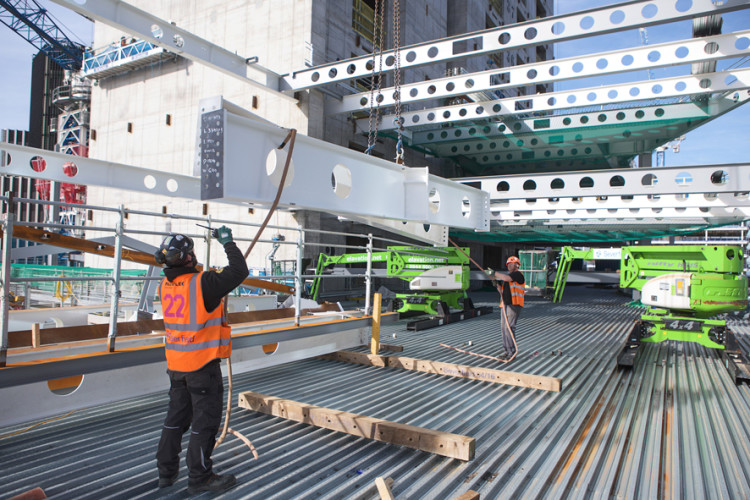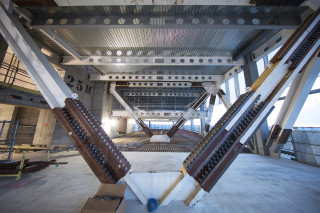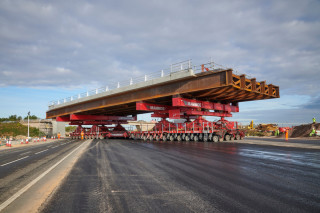The overall market for structural steelwork in the UK appears to be sailing a steady course. Forecasts from The British Constructional Steelwork Association (BCSA) indicate that consumption will remain flat throughout 2019 with a slight boost in demand through 2020.
As with many other construction materials, Brexit’s influence can be seen in the cost pressure on all construction materials over the past year or so, driven by the weakness of the pound and fluctuations in raw materials costs. But Brexit has also created what might turn out to be pent-up demand resulting from investment programmes having been put on hold as developers and other investors adopt a cautious, wait-and-see approach.
“Steelwork contractors do report very high levels of projects on hold,” confirms Sarah McCann-Bartlett, director general of the BCSA. “This means that the future workload is uncertain and is dependent on the Brexit outcome – although it may be that the market is simply waiting for a decision and no matter how the UK exits from the EU, we may see many of these projects released when we have more certainty.”

This uncertainty has a marked effect on private sector projects and in particular the commercial office building market. In 2019 the demand for structural steel is forecast to drop to less than 90,000 tonnes thanks to continuing uncertainty over Brexit, magnified by concomitant factors such as excess capacity and weakness in the London market.
And the UK capital is the crucial market here because of the scale of the developments. So, although BCSA members report that there is a demand for commercial buildings in the regions, this does not in any way make up for the lack of demand in London.
The issue here is simply scale: a large office in, say, Birmingham might require between 2,000 and 5,000 tonnes of steel but a large office building in London would consume upwards of 10,000 tonnes.
There are highlights that would seem to tell a different tale but these are atypical. Leading steelwork fabricator Severfield, for instance, has an order to supply 15,000 tonnes of structural steelwork for the new Google headquarters, an 11-storey building in London’s Kings Cross. This is due to be substantially complete in 2020 but Severfield’s £50m order was secured almost two years ago, in December 2017.
So the market will still remain flat, even though there are one or two large London projects in development, as these are nowhere near ready for steelwork.
By contrast, the market for warehousing and distribution facilities has driven the demand for structural steelwork in the industrial buildings sector to historically high levels. The industrial sector is now the biggest consumer of structural steelwork, accounting for 433,000 tonnes this year – or 96% of current demand, according to McCann-Bartlett.
In part this can be seen to reflect the increasing importance of e-commerce, which requires more warehousing than traditional retailing, yet Brexit has also played some part, as the United Kingdom Warehousing Association (UKWA) notes. Peter Ward, the UKWA chief executive, says that the prospect of a no-deal Brexit has ramped up demand at a time when competition for space is rising from online retailers.
His view is reinforced by a recent report from property consultant Savills that estimates that around 7.5 million square feet of warehouse space is currently under construction. This is equivalent to 1.4% of the total existing capacity of around 514 million square feet and suggests that the demand for new warehousing will continue to be robust.
To some degree, the public sector market is less volatile. There are spending plans and targets that, once decided, will not change without at least some debate. But there have been delays, and work on structures for the biggest public sector project, HS2, has been pushed back.
The BCSA was expecting to see orders for steelwork on HS2 placed by early 2019 with fabrication starting later this year, but no orders have yet been placed. Consequently, the BCSA’s forecast for structural steelwork consumption in the bridges sector has been revised to 10% growth this year and 40% in 2020.
Overall, though, the market for bridges remains steady. Leading fabricator Cleveland Bridge UK, for instance, says that it is in better shape this year than it was in 2018.
“Cleveland Bridge started 2019 in a strong position, we have a good order book and healthy pipeline for the short and longer term,” says managing director Chris Droogan. “In 2018 we saw challenging market conditions, but CBUK were in a strong position. Targeted investment in areas such as training, marketing, and sustainability put us in a great position to take advantage of the movement on the big infrastructure projects that we are starting to see.”
Meanwhile other infrastructure markets are growing strongly. Waste-to-energy and nuclear in particular are performing well, with the BCSA predicting 7% growth in structural steelwork consumption in 2019 and 11% growth in 2020.

Lack of investment for new buildings in schools over the past few years has seen a decline in steel consumption in this sector. This year will not buck this trend, with steelwork consumption falling to just 74,000 tonnes.
Looking at this workload, McCann-Bartlett concludes: “The UK structural steelwork sector is in good shape and UK steelwork contractors have the capacity and capability to deliver the future pipeline of work.”
Nonetheless the construction industry as a whole does face some difficulties, not least the low margins that main contractors accept in order to win work. The rigours of cashflow and volatile prices for materials then lead to some big names struggling and others, including Dawnus and Lakehouse, going into administration. Naturally that leads to financial difficulties which then have a domino effect, putting major pressure on subcontractors such as steelwork fabricators and other specialists.
Another issue looming for all specialists in the supply chain is the new VAT reverse charge. Due to come into force in October (dovetailing nicely with Brexit) the reverse charge requires that the customer receiving the service has to pay the VAT directly to HM Revenue & Customs instead of paying the supplier. The charge applies through the supply chain where payments are required to be reported through the Construction Industry Scheme.
This measure not only reduces cashflow but also increases the administration costs of all the businesses concerned. The BCSA is one of 15 signatories to a letter from the construction industry to chancellor Sajid Javid seeking six-months’ grace “to give the industry some breathing space following Brexit, for HMRC to fully assess the impact of the changes on the industry, and to ensure businesses are adequately prepared”.
The BCSA has gone further, calling on the chancellor to use this time to review the decision altogether.
Another issue for concern is the fate of British Steel. In 1970 the UK was the world’s fourth-largest steel producer (the US, Japan and West Germany were the top three) but now production has fallen by two-thirds. In May British Steel collapsed after the owner, Greybull Capital, failed to convince the government to step in with a rescue plan.
With the support of a government indemnity it has been business as usual over the past few months: the company continues to trade, take orders, produce and despatch steel. At the time of writing it is reported that there are three bidders and the frontrunner is Ataer Holdings, owned by the Turkish military pension fund Oyak, which is also the largest shareholder in the Turkish steelmaker Erdemir.
The fate of the UK’s second-largest steel manufacturer will no doubt have an effect on the structural steel sector but Sarah McCann-Bartlett believes that it is not crucial. “The major European mills supplying steel to the UK, along with other high-quality international mills, have the capacity to fully service the needs of the UK structural steelwork market, if required,” she says. “There are also other UK steel mills producing a variety of other products for the UK construction sector.”
Crucially, though, at what price? Basic economics dictate that if demand remains constant and the supply shrinks then price must rise – and what can the market stand when the cost of materials is already rising?
For the future, the BCSA is looking at the opportunities offered by offsite manufacturing.
Innovate UK, a government body, is supporting the study of how integrated offsite steel modules could boost productivity in the construction industry. The idea is that using these modules in the design, manufacture and construction of mainstream steel-framed buildings would be much faster and far more efficient and would also improve site safety and address on-site skill shortages.
Although Innovate UK only got started in April, there are examples of how this approach can work, including the London Bridge redevelopment, the ‘Cheesegrater’ at Leadenhall in the City of London, and the erection of fully-integrated road gantries. McCann-Bartlett is optimistic that Innovate UK might prove to be the “Uber moment” for integrated off-site fabrication.
“This project will show the mainstream buildings market, including engineers, main contractors and steelwork contractors, how to include integrated steel modules that incorporate the M&E and have been manufactured off site into their projects,” she said.
Yet even if these ambitions are realised, they will not affect demand as such. Off-site fabrication offers an alternative means to fulfil demand, and demand depends entirely upon the political landscape and the trading relations established in the next few months and years. To borrow a phrase from US president Bill Clinton: “It’s the economy, stupid.”
This article was first published in the September 2019 issue of The Construction Index magazine (magazine published online, 25th of each month.)
UK readers can have their own copy of the magazine, in real paper, posted through their letterbox each month by taking out an annual subscription for just £50 a year. Click for details.
Got a story? Email news@theconstructionindex.co.uk






